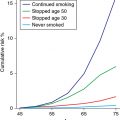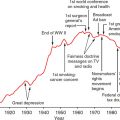You are director of the World Health Organization and ask your global experts which cancer should receive the most attention to prevent its incidence and mortality and consequently decrease the burden of cancer mortality worldwide the most. Learning Objectives: 1. What is the overall cancer mortality worldwide? 2. What are the cancers that cause the highest number of cancer deaths? 3. How has the lung cancer mortality rate changed over the last century? 4. Which parts of the world have the highest lung cancer mortality? It is estimated that in 2018 worldwide 18.1 million people were diagnosed with cancer, and 9.6 million died of cancer. Non-communicable diseases are now the cause for most deaths globally; cancer is expected to be the leading cause of deaths in the 21st century.1 In 2018, the global incidence of lung cancer was 2,093,876 (11.6% of all cancers), and global deaths by lung cancer were 1,761,007. Of all cancer deaths, 18.4% were due to lung cancer.1 In 2012, the lung cancer incidence rates were lower, 1.8 million, which demonstrates the expanding epidemic of lung cancer worldwide.2,3 Lung cancer is the leading cause of deaths caused by cancer in men and women in high-income countries based on registry data collected by the International Agency for Research on Cancer (IARC) and published by GLOBOCAN (Global Cancer Registry provided by the UICC (Union for International Cancer Control)) and the World Health Organization (WHO) (Figure 2-1). Smoking is the main reason for the high incidence of lung cancer. WHO estimated that 100 million people died of tobacco’s effect in the 20th century, and for the 21st century, WHO predicted that 1 billion could die due to smoking.4 Figure 2-1. Estimated new cancer cases and deaths worldwide. (Reproduced with permission from Bray F, Ferlay J, Soerjomataram I, Siegel RL, Torre LA, Jemal A. Global cancer statistics 2018: GLOBOCAN estimates of incidence and mortality worldwide for 36 cancers in 185 countries. CA Cancer J Clin. 2018;68(6):394-424. © 2018 American Cancer Society.) The incidence rate of lung cancer varies significantly by country following the country’s usage of tobacco in the population (Figures 2-2 and 2-3). Figure 2-2. Cancer mortality by country. (From Bray F, Ferlay J, Soerjomataram I, Siegel RL, Torre LA, Jemal A. Global cancer statistics 2018: GLOBOCAN estimates of incidence and mortality worldwide for 36 cancers in 185 countries. CA Cancer J Clin. 2018;68(6):394-424. Reproduced with permission from World Health Organization. © WHO 2018. All rights reserved.) Figure 2-3. Lung cancer incidence by region and gender. (Reproduced with permission from Bray F, Ferlay J, Soerjomataram I, Siegel RL, Torre LA, Jemal A. Global cancer statistics 2018: GLOBOCAN estimates of incidence and mortality worldwide for 36 cancers in 185 countries. CA Cancer J Clin. 2018;68(6):394-424. © 2018 American Cancer Society.) The highest mortality rates in males were in Central and Eastern Europe and China, 44-47/100,000, and the lowest rates were in Central America and Africa (4-14/100,000). The highest lung cancer mortality rates for women were in the United States (23.5/100,000) and Northern Europe (19/100,000).2,5,6 In countries that had an early peak of the tobacco epidemic in the 1950s and 1960s, lung cancer has been decreasing (United States, Western Europe), while for those countries with a recent uptake of general tobacco consumption (China, India, Indonesia, Africa) lung cancer has been on the rise later, decreasing later or continuing to rise in some countries (Figure 2-4). Figure 2-4. (A) Trends in lung cancer mortality in men for select countries; (B) trends in lung cancer mortality in women for select countries. (Reproduced with permission from Islami F, Torre LA, Jemal A. Global trends of lung cancer mortality and smoking prevalence. Transl Lung Cancer Res. 2015;4(4):327-338.) Half of the lung cancer cases in the world occur presently in developing countries, and the overall number of lung cancer deaths globally has increased by 51% since 1985.7 Despite the overall trend of improving incidence rates in high-income countries, lung cancer is the leading cause of cancer death in many countries. Lung cancer incidence rates have declined in men and women in the United States over the last 10 years. Lung cancer death rates declined in men by 4% and in women by 2.3% from 2009 to 2015. In 2018, in the United States 135,720 people were estimated to die from lung cancer, 72,500 men and 63,220 women.8 In the United States, there are as many deaths due to lung cancer as there are combined deaths due to colon cancer (50,630), breast cancer (41,400), prostate cancer (29,430), lymphomas (20,960), and kidney cancers (14,970) (Figure 2-5).9 Figure 2-5. Ten leading cancer incidence and death rates in the United States by gender from 1930 to 2015. (Reproduced with permission from Siegel RL, Miller KD, Jemal A. Cancer statistics, 2018. CA Cancer J Clin. 2018;68(1):7-30. © 2018 American Cancer Society.) The mortality in the United States varies by gender and ethnicity. The highest mortality is seen in black men (66.9/100,000) and the lowest in Hispanic women (13.3/100,000) (Table 2-1).9 TABLE 2-1 Lung Cancer Mortality by Gender and
2
EPIDEMIOLOGY OF LUNG CANCER
GLOBAL LUNG CANCER MORTALITY





LUNG CANCER IN THE UNITED STATES

Ethnicity, United States, 2015
Stay updated, free articles. Join our Telegram channel

Full access? Get Clinical Tree







